This is a guest blogpost by Josiah Fiscus. Josiah Fiscus is a 31-year-old gamer from Pittsburgh, PA who has been playing CCGs and designer board games for over two decades. When he’s not at the game table, you’ll find him playing drums and serving as a deacon in his local church or enjoying time outdoors with his wife, Erin, and two kids (ages 5 and 3).
The place that Epic most differentiates itself from the granddaddy of CCGs, Magic, is in the Battle Phase. Epic provides a dizzying array of attack options that increase exponentially the more potential attackers and blockers there are. Let’s consider some fundamental principles that will lead to more productive attacks.
Principle 1: Attack alone for maximum damage. In most cases, sending a single attacker into battle provides the optimum amount of health loss for your opponent. Reduction of your opponent’s health is often (but not always) the goal of an attack, so usually this method is correct. The drawback to attacking with multiple Champions at once is that a single blocker (even a 1/1 Human) can absorb all the damage. Yes, cards like Ceasefire will punish you for this strategy. But, on the other hand, a card like Spike Trap will punish you for attacking in multiples. Still, if you fear cards like Lying In Wait, sending an additional expendable Champion (such as a token) along with your main attacker is often correct, as you give up very little damage if the entire attack is blocked (just whatever the token would have attacked for on its own). So aside from sending a token along, attack alone when trying to deal damage.
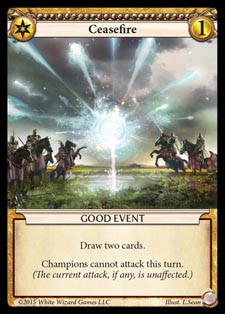
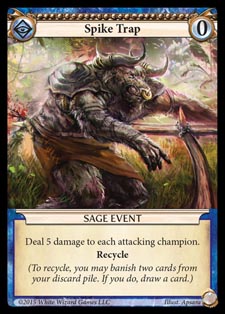
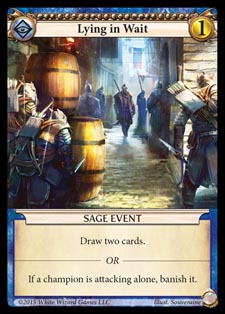
Principle 2: Attack in groups to kill pesky blockers. Consider the situation where you have two 4/4 demon tokens facing a 7/7 potential blocker. Attacking with your tokens one-by-one guarantees you 4 damage will get through (barring Ambush and removal), but you will lose one of your tokens. Attacking with both tokens at once, however, forces your opponent to either take the 8 damage to preserve the blocker or else lose the blocker to kill just one of your demons. Note that you will lose a token either way if a block occurs, but giving up a mere 4 damage to kill a 7/7 champion is usually well worth it. Sometimes attacks like this can force your opponent into making bad choices.
Principle 3: Wasting your evasion is not actually a big deal. One of the first axioms new players develop is that it is a bad idea to attack with an Airborne or Unblockable Champion along with one who is not. By doing so, you effectively cause that Champion to lose their evasion ability, because if any Champion in the attacking group is blocked, the entire group becomes blocked. However, since the goal of attacking with multiple Champions at once should actually be to bait your opponent into blocking, this axiom is invalid. Consider the situation where you have a 4/4 Unblockable Champion and a 4/4 demon token against your opponent’s potential 7/7 blocker. If you are trying to force damage through, you just attack with the 4/4 Unblockable. However, if you want to force your opponent to either take 8 damage or else lose the 7/7, you should, in fact, attack with both at once, just as in Principle 2, even though you lose the benefit of Unblockable.
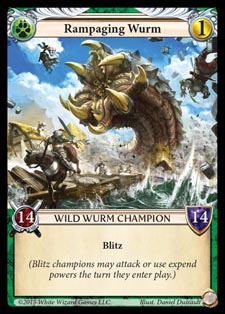 Principle 4: Attack first, then play cards. This is especially true for Champions with Blitz. Your opponent will make less optimal blocks the less information he/she has available. When you attack with your 2/2 wolf token and your opponent blocks with the only Champion available, prepare for weeping and gnashing of teeth when you follow up this attack with a 14-offense Blitz Champion from your hand. Moreover, once your opponent realizes you are playing this way (and it might even behoove you to point it out), it may allow your 2/2 wolf token to get in unblocked next time since your opponent fears a high-offense Blitz Champion which you may not even have in your hand!
Principle 4: Attack first, then play cards. This is especially true for Champions with Blitz. Your opponent will make less optimal blocks the less information he/she has available. When you attack with your 2/2 wolf token and your opponent blocks with the only Champion available, prepare for weeping and gnashing of teeth when you follow up this attack with a 14-offense Blitz Champion from your hand. Moreover, once your opponent realizes you are playing this way (and it might even behoove you to point it out), it may allow your 2/2 wolf token to get in unblocked next time since your opponent fears a high-offense Blitz Champion which you may not even have in your hand!
Principle 5: Discretion is the better part of valor. In other words, know when you need a blocker more than you need extra damage. This is one of the concepts that newer players often miss. Just because Thrasher Demon has Blitz does not mean it is always correct to turn it sideways the second it hits the table (in fact, it is very often incorrect). Consider what your opponent has on the table and what is likely to attack you next turn. Make sure you aren’t leaving yourself open to something like a surprise Mighty Blow when you are in an otherwise excellent board position.
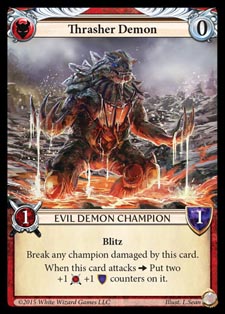
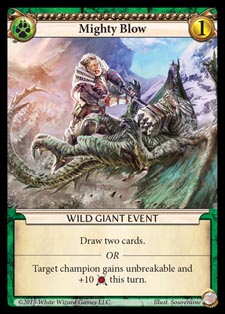
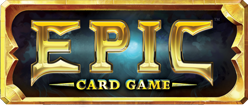
Recent Comments